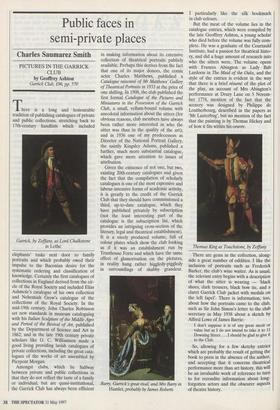Public faces in semi-private places
Charles Saumarez Smith
PICTURES IN THE GARRICK CLUB by Geoffrey Ashton Garrick Club, f96, pp. 570 There is a long and honourable tradition of publishing catalogues of private and public collections, stretching back to 17th-century handlists which included
Garrick, by Zoffany, as Lord Chalkstone in Lethe elephants' tusks next door to family portraits and which probably owed their impulse to the Baconian desire for the systematic ordering and classification of knowledge. Certainly the first catalogues of collections in England derived from the cir- cle of the Royal Society and included Elias Ashmole's catalogue of his own collection and Nehemiah Grew's catalogue of the collections of the Royal Society. In the mid-19th century, John Charles Robinson set new standards in museum cataloguing with his Italian Sculpture of the Middle Ages and Period of the Revival of Art, published by the Department of Science and Art in 1862; and in the late 19th century private scholars like G. C. Williamson made a good living providing lavish catalogues of private collections, including the great cata- logues of the works of art assembled by Pierpont Morgan.
Amongst clubs, which lie halfway between private and public collections in that they do not reflect the taste of a family or individual, but are quasi-institutional, the Garrick Club has always been efficient in making information about its extensive collection of theatrical portraits publicly available. Perhaps this derives from the fact that one of its major donors, the comic actor Charles Matthews, published a Catalogue raisonne of Mr Matthews' Gallery of Theatrical Portraits in 1933 at the price of one shilling. In 1908, the club published the first formal Catalogue of the Pictures and Miniatures in the Possession of the Garrick Club, a small, vellum-bound volume with anecdotal information about the sitters (for obvious reasons, club members have always been rather more interested in who the sitter was than in the quality of the art); and in 1936 one of my predecessors as Director of the National Portrait Gallery, the saintly Kingsley Adams, published a further, much more substantial catalogue, which gave more attention to issues of attribution.
Given the existence of not one, but two, existing 20th-century catalogues and given the fact that the compilation of scholarly catalogues is one of the most expensive and labour-intensive forms of academic activity, it is greatly to the credit of the Garrick Club that they should have commissioned a third, up-to-date catalogue, which they have published privately by subscription (not the least interesting part of the catalogue is the subscription list, which provides an intriguing cross-section of the literary, legal and theatrical establishment). It is a nicely produced volume, full of colour plates which show the club looking as if it was an establishment run by Trusthouse Forte and which have the same effect of glamorisation on the pictures, in reality hung rather higgledy-piggledy in surroundings of shabby grandeur.
Barry, Gamck's great rival, and Mrs Barry in Hamlet, probably by James Roberts I particularly like the silk bookmark in club colours.
But the meat of the volume lies in the catalogue entries, which were compiled by the late Geoffrey Ashton, a young scholar who died before the volume was fully com- plete. He was a graduate of the Courtauld Institute, had a passion for theatrical histo- ry, and did a huge amount of research into who the sitters were. The volume opens with Frances Abington as Lady Bab Lardoon in The Maid of the Oaks, and the style of the entries is evident in the way that there is a brief resume of the plot of the play, an account of Mrs Abington's performance at Drury Lane on 5 Novem- ber 1774, mention of the fact that the scenery was designed by Philippe de Loutherbourg, described in the papers as `Mr Lanterbug', but no mention of the fact that the painting is by Thomas Hickey and of how it fits within his oeuvre.
Thomas King as Touchstone, by Zoffany
There are gems in the collection, along- side a great number of oddities. I like the inclusion of portraits such as Frederick Barker, the club's wine waiter. As is usual, the relevant entry begins with a description of what the sitter is wearing — 'black shoes, dark trousers, black bow tie, and a claret Garrick Club jacket with medals on the left lapel'. There is information, too, about how the portraits came to the club, such as Sir John Simon's letter to the club secretary in May 1938 about a sketch by Alfred Lowe of James Barrie: I don't suppose it is of any great merit or value but as I do not intend to take it to 11 Downing Street ... I should be glad to give it to the Club.
So, allowing for a few sketchy entries which are probably the result of getting the book to press in the absence of the author, and accepting that it concerns theatrical performance more than art history, this will be an invaluable work of reference to turn to for recondite information about long- forgotten actors and the obscurer aspects of theatre history.


































































 Previous page
Previous page